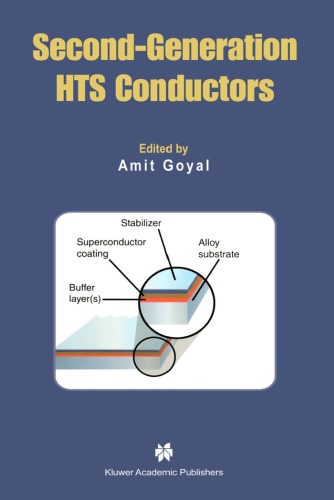

Most ebook files are in PDF format, so you can easily read them using various software such as Foxit Reader or directly on the Google Chrome browser.
Some ebook files are released by publishers in other formats such as .awz, .mobi, .epub, .fb2, etc. You may need to install specific software to read these formats on mobile/PC, such as Calibre.
Please read the tutorial at this link: https://ebookbell.com/faq
We offer FREE conversion to the popular formats you request; however, this may take some time. Therefore, right after payment, please email us, and we will try to provide the service as quickly as possible.
For some exceptional file formats or broken links (if any), please refrain from opening any disputes. Instead, email us first, and we will try to assist within a maximum of 6 hours.
EbookBell Team

4.7
36 reviews
ISBN 10: 1402081170
ISBN 13: 978-1402081170
Author: Amit Goyal
The discovery of high-temperature superconductors (HTS) in 1986 by two IBM scientists triggered an unprecedented wave of research and development worldwide, driven by the immense potential of these materials for practical applications. However, the initial excitement was soon tempered by the formidable challenge of fabricating HTS into usable forms with acceptable superconducting properties.
Progress toward this goal has been hindered by intrinsic material issues, including weak links, flux creep, and poor mechanical properties. Early studies of the critical current density (J_c) in HTS materials revealed that polycrystalline samples, which contain a distribution of grain boundaries, exhibit significantly lower (J_c) than single crystals. High-angle grain boundaries, in particular, act as Josephson-coupled weak links, leading to a pronounced field-dependent suppression of the supercurrent across the boundary.
For clean, stoichiometric boundaries, the grain boundary critical current density depends primarily on the misorientation angle. This relationship has been extensively studied in YBa(_2)Cu(3)O(7) (YBCO) using epitaxial films grown on bicrystal substrates, covering [001] tilt, [100] tilt, and [100] twist boundaries. In all cases, high-angle boundaries were found to behave as weak links. Similar experiments on artificially fabricated [001] tilt bicrystals in Tl-2208, Tl-2223, and Nd({1.85})Ce({0.15})CuO(_4) confirmed the same behavior: the grain boundary misorientation strongly influences (J_c). Data from Bi-2212 bicrystals further indicate that most large-angle [001] tilt and [001] twist boundaries function as weak links.
These findings suggest that the variation of (J_c) with misorientation angle is a universal feature of all high-(T_c) superconductors. Consequently, the low (J_c) observed in randomly oriented polycrystalline HTS can be explained by the scarcity of low-angle boundaries and the prevalence of high-angle ones, which impede long-range current flow.
Despite these obstacles, three HTS materials were successfully fabricated in polycrystalline form using conventional processing techniques, achieving modest (J_c) values. These include Bi-2223 powder-in-tube conductors, Tl-1223 spray-pyrolyzed films, and Bi-2212 melt-processed thick films. Collectively, these conductors became known as the First-Generation HTS conductors (or wires).
Chapter 1 – Methods to Produce Biaxially Textured Substrates
Chapter 2 – IBAD Template Films for HTS Coated Conductors
Chapter 3 – Epitaxial Superconductors on Rolling-Assisted-Biaxially-Textured-Substrates (RABiTS)
Chapter 4 – Inclined Substrate Deposition
Chapter 5 – ISD by Thermal Evaporation
Chapter 6 – Pulsed Laser Deposition of YBa₂Cu₃O₇−δ for Coated Conductor Applications: Current Status and Cost Issues
Chapter 7 – Methods of HTS Deposition: Thermal Evaporation
Chapter 8 – Sputtering of YBa₂Cu₃O₇−δ
Chapter 9 – Pulsed Electron-Beam Deposition of High Temperature Superconducting Films for Coated Conductor Applications
Chapter 10 – BaF₂ Post-Deposition Reaction Process for Thick YBCO Films
Chapter 11 – Issues and Progress Related to the Continuous Ex-Situ BaF₂ Processing of Long-Length YBCO Coated Conductors
Chapter 12 – Solution Deposition of YBa₂Cu₃O₇−δ Coated Conductors
Chapter 13 – Non-Fluorine Based Bulk Solution Techniques to Grow Superconducting YBa₂Cu₃O₇−δ Films
Chapter 14 – Jet Vapor Deposition for Continuous, Low-Cost Manufacture of High Temperature Superconducting Tape
Chapter 15 – Processing of Long-Length Tapes of High-Temperature Superconductors by Combustion Chemical Vapor Deposition
Chapter 16 – MOCVD Growth of YBCO Films for Coated Conductor Applications
Chapter 17 – LPE Processing for Coated Conductor
Chapter 18 – Ex-Situ Processing of Ti-Containing Films
Chapter 19 – Epitaxy of Hg-Based High-Tc Superconducting Thin Films
secondary conductors definition
secondary conductors
hts 2005
secondary conductor size
the secondary conductors are terminated using mechanical lugs
Tags: Amit Goyal, Second, generation, Conductors